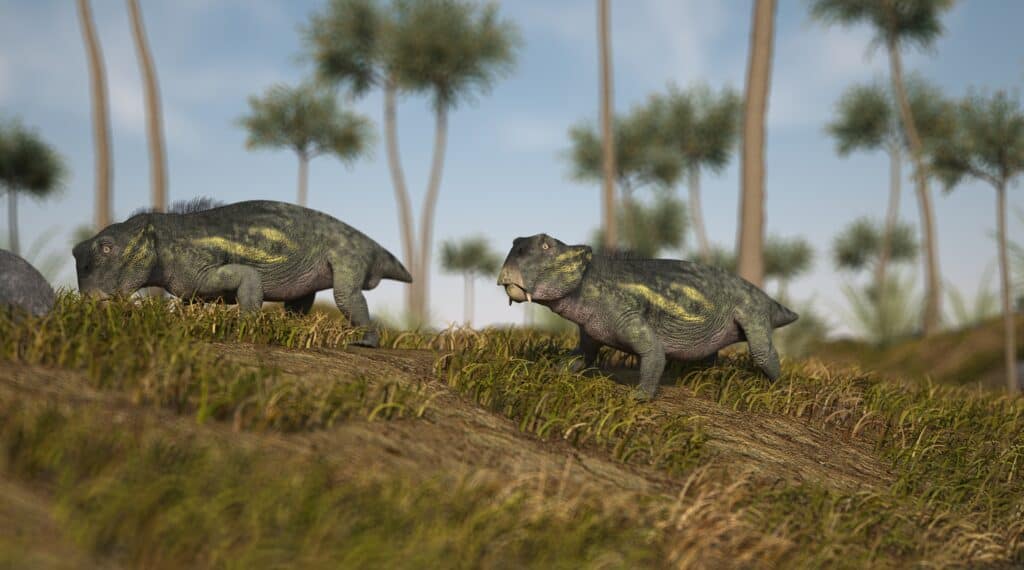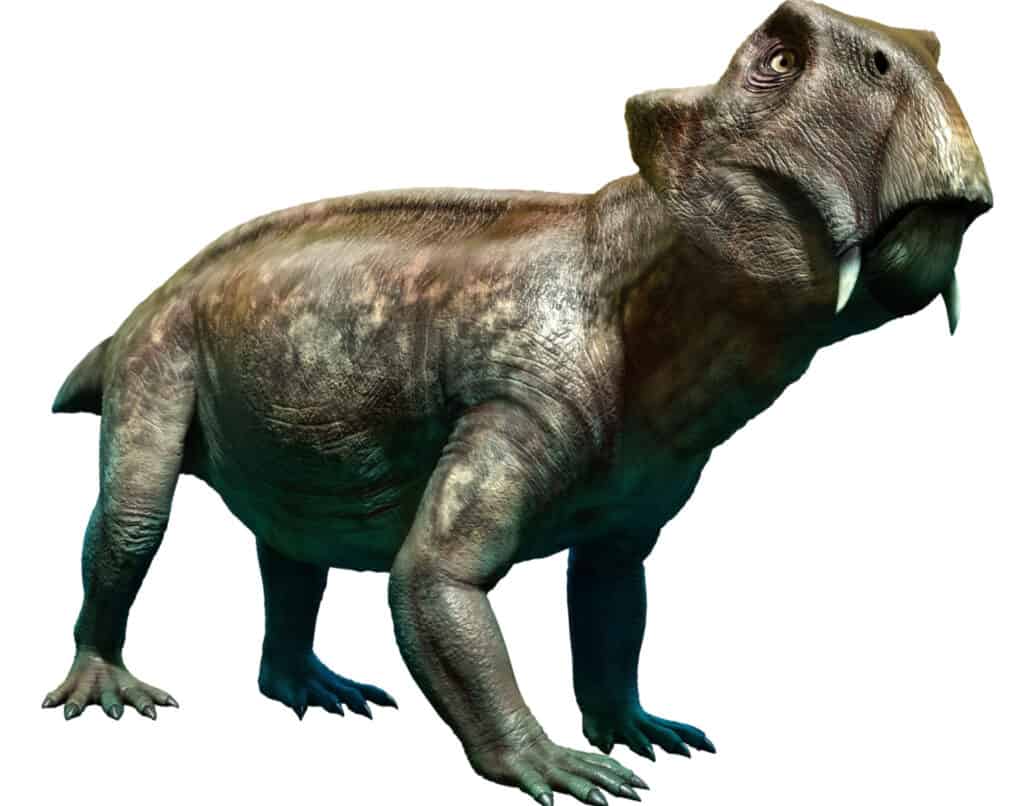The fossil record has no shortage of ridiculous-looking animals, from elephants with hair all over their body like a Yeti to armored dinosaurs built like an armadillo. The Lystrosaurus was a freak of nature that lived several million years ago. This creature lived between the Late Permian to the Early Triassic periods. Fossils of this heavily-built, beaked herbivore have been discovered mainly in Africa and in parts of what is now India, China, Mongolia, European Russia, and Antarctica.
Lystrosaurus was a dicynodont. This group of Permian herbivores is known for their bizarre appearance. They had two tusk-like canines protruding from the upper jaws—a strange dentition for an herbivore. Even more interesting, they had horny, toothless beaks, like a turtle’s. Dicynodonts are also known as “two dog tooth.”
Name, Species, and Classification
The name Lystrosarus is derived from two Greek words, “listron,” which means “shovel,” and “sauros,” which means “lizard.” The name is a fitting name for this beaked herbivore because it references the possible burrowing habit of this animal. Only about four species have been identified officially in this genus. However, the number of species was higher than this in the past.
The Lystrosaurus maccaigi is the largest and apparently most specialized species among the four. Other members of this genus include L. curvatus, L. murrayi, and L. declivis. Lystrosaurus curvatus is the least specialized species.
So far, most fossils have been recovered from the Karoo Basin of South Africa. The basin had numerous bones, which helped scientists classify the genus and describe its members. The basin may have had animals from different species within the genus. However, this is still debatable.
Lystrosaurus murrayi and Lystrosaurus declivis only lived during the Triassic sediments, which means they evolved after the Permian extinction event. The other two species lived during the Late Permian and may have survived into the Triassic.
What Did Lystrosaurus Look Like?

Lystrosaurus was a small, pig-sized herbivore.
©Kostiantyn Ivanyshen/Shutterstock.com
Lystrosaurus was approximately the size of a pig and looked like a cross between a pig and a lizard. It was a burrower with powerful and massive forelimbs. It could have dug a den for itself every night and in unfavorable situations.
Based on the structure of its shoulders and the position of the hip joints, Lystrosaurus moved with a semi-sprawling gait. It was about three to eight feet long and weighed about 200 pounds.
The massive body weight of this beaked herbivore was supported on four limbs with five toes on each foot. The jaw muscles were unusually far forwards on the skull, taking up a lot of space on the top and back of the skull. As a result, the eyes were set high and far forwards on the skull, and the face was short.
What Did Lystrosaurus Eat?
Despite the obvious downward canines, Lystrosaurus did not feed on flesh. Rather, it was a plant-eater. Lystrosaurus had no teeth. Instead, it had a horny, beak-like jaw similar to that of the turtle. The jaws could grip and cut plants with relative ease. Since their jaws had no teeth, they used a bony plate for grinding food. Experts think they may have fed on rare flowers, berries, and leaves from primitive plants that lived back in the Permian and Triassic.
Lystrosaurus Habitat

The Lystrosaurus was a pig-sized dinosaur that ate plant life.
©Warpaint/Shutterstock.com
Lystrosaurus lived about 250 million years ago. The duration of this animal’s existence straddles the boundary between the Late Permian and Early Triassic periods. During this period, the landmasses on earth formed a supercontinent known as Pangea. Lystrosaurus lived in Pangea’s southern hemisphere. Fossils of this animal have been recovered from the Karoo basin in present-day South Africa and Russia, Mongolia, Antarctica, and China.
The earth was much warmer during the Triassic period than it is today. Some paleontologists believe Lystrosaurus thrived in the hot, arid, oxygen-depleted environments that dominated the first few million years of the Triassic Period. Those that lived in Antarctica most likely acquired some form of hibernation-like adaptation.
Lystrosaurus was a burrower, capable of making its dens deep underground and tending its young there. The forelimbs were typically more robust than the hindlimb, which suggests that they relied on the forelimb to burrow into the soil. A burrowing lifestyle also suggests that they lived in a habitat where they could easily dig into the soil whenever needed.
The Beaked Herbivore that Survived Permian Extinction?
The extinction event that ended the Permian was one of the planet’s most severe extinction events. It wiped out up to 81% of marine species and 70% of terrestrial animals. Interestingly, despite the severity of this extinction event, Lystrosaurus somehow survived and even dominated the planet for several million years afterward.
Paleontologists have found fossils of at least two species in formations dating back to the Triassic Period. Experts think one unidentified species survived the events that led to the disappearance of most of life on the planet during the Permian and was dominant enough to evolve into two distinct species identified from the Triassic Period.
Since they were the biggest land animals then, there was no competition from other herbivores and no active predators. This allowed the genus to thrive, becoming the most common terrestrial vertebrates of the Early Triassic. Experts think Lystrosaurus made up 75% of terrestrial vertebrates after the Permian extinction.
They were not the only Permian therapsids that survived the extinction. However, none of the other survivors were as adaptable to life after the Permian extinction as the Lystrosaurus.
Scientists have proposed different theories to explain the Lystrosaurus’s unprecedented survival during the Permian extinction and its dominance afterward. Possible explanations include:
- An ability to enter into a prolonged hibernation-like state during unfavorable conditions
- Burrowing to avoid contaminated surface air
- A semi-aquatic habit
- Lack of specialization
- A lack of predators
Any of these factors or even a combination of them might have contributed to the dominance of this ridiculous-looking beaked herbivore when other organisms could not survive.
Up Next
- Discover 5 Incredible Permian Period Animals: Facts, Information, and Timeline
- Meet the Egg-Laying Ancient Predator that Looks Like an Alligator
- Discover the Falcon-Sized Dragon Fly That Ate Lizards
The photo featured at the top of this post is © Kostiantyn Ivanyshen/Shutterstock.com
Sources
- Prehistoric Wildlife, Available here: http://www.prehistoric-wildlife.com/species/l/lystrosaurus.html
- Dinopedia, Available here: https://dinopedia.fandom.com/wiki/Lystrosaurus
- Wikipedia, Available here: https://en.wikipedia.org/wiki/Lystrosaurus
- Study, Available here: https://study.com/academy/lesson/lystrosaurus-facts-lesson-quiz.html
Thank you for reading! Have some feedback for us? Contact the AZ Animals editorial team.






